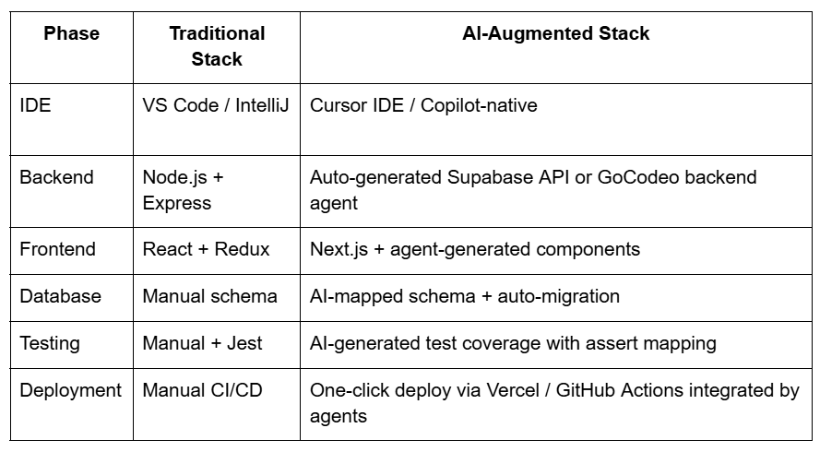
The shift introduced by AI in the realm of software development is not speculative, it is active, measurable, and increasingly standardized. What began as simple autocomplete functionality in IDEs has evolved into fully contextual, multi-agent systems capable of understanding user intent, generating production-ready code, integrating third-party services, and even managing deployment workflows.
The role of AI for coding, spanning from GPT-4o, Claude, and Copilot X to agentic platforms like GoCodeo, is already altering what it means to be a developer. While the entire spectrum of software engineering is being influenced, the most immediate impact is being felt by junior developers, who traditionally take on the simpler, more repetitive, and lower-risk tasks that these AI systems now perform with increasing accuracy.
This blog offers an in-depth, technical analysis of how this evolution is altering hiring trends, redefining early-career developer expectations, and mandating a new kind of fluency that merges traditional programming foundations with intelligent automation systems.
The earliest versions of AI-assisted development tools were essentially next-token predictors, pattern matchers trained on syntax. However, today’s tools go significantly beyond that:
For developers, this fundamentally alters the terrain. Instead of manually designing boilerplate, you’re increasingly directing and reviewing AI-generated architectures.
Historically, junior engineers were assigned narrow-scope tasks, form creation, CRUD API endpoints, state management, integrating REST APIs, writing CSS modules, or fixing minor bugs. These tasks served as both onboarding exercises and actual production contributions.
However, these exact responsibilities are now automated by prompt-driven AI workflows.
Consider a typical feature request:
In this new flow, junior developers are increasingly expected to:
The technical literacy required is higher, not because the developer must write everything from scratch, but because they must verify, critique, and evolve what the AI outputs.
Recruiting patterns are already responding to the rise of AI-enhanced workflows.
This trend is not limited to startups. Enterprises integrating LLM copilots into their SDLC are reevaluating their hiring strategies, opting for junior engineers who can demonstrate systems thinking, familiarity with agentic workflows, and the ability to reason across abstraction layers.
We’re witnessing the emergence of a new baseline development environment, an "AI-native" stack where agents, toolchains, and autonomous workflows are default.

These changes dramatically affect what a "productive" junior developer looks like. A dev who can only write a RESTful Express API by hand may now be outpaced by one who can generate it, validate it, and connect it to Supabase using a multi-agent tool.
This doesn't trivialize development, it shifts it to higher levels of composition and decision-making.
With automation swallowing low-level tasks, human developers must pivot toward capabilities that AI cannot easily mimic. This does not mean abandoning foundational programming knowledge, but rather applying it in new contexts.
a. Architecture Comprehension and Decomposition
b. Debugging and Tooling Literacy
c. Prompt Design and Refinement
d. Environment Ownership
These are not "AI-proof" skills, they’re AI-symbiotic. They make the developer more valuable in a hybrid loop.
The most urgent risk for junior developers today is not job displacement per se, but career obsolescence by stagnation.
This has major implications for developer education:
The most successful early-career developers will not resist AI, they will augment their trajectory with it.
1. Use AI in Every Project
2. Learn Prompt Engineering
3. Study Systems, Not Just Syntax
4. Focus on Real-World Shipping
This is not a shortcut; it’s a redirection of where foundational learning is happening.
AI for coding is redefining the early career experience. The job isn’t disappearing, it’s being refactored. The repetitive, syntactical, low-context work is being absorbed by LLMs and coding agents. In its place, a new kind of junior developer is emerging, one who operates at a systems level earlier in their career, who collaborates with AI tools instead of competing against them, and who understands not just code, but the workflows, environments, and abstractions that turn that code into real products.
For developers who embrace this shift, the future is wide open. For those who don’t, it’s already moving on.